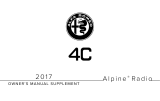
4-EN
Contents
ENGLISH
Other Functions
Displaying the Text.................................................. 22
About the indication display ........................... 23
About “Text” .......................................................... 23
Option Menu Setting.............................................. 23
Applying TuneIt........................................................ 24
Adjusting the sound via Smartphone .......... 24
Facebook Notification Function ..................... 25
Receiving Notification
(Ready on future update) ........................................25
Displaying Notification List
(Ready on future update) ........................................25
SETUP
Setting.......................................................................... 25
General Setting..................................................... 26
Setting the Clock Display (Clock Mode).............26
Setting of Calendar Display Pattern Switching
(Calendar)......................................................................26
Setting the AUX SETUP mode................................26
Setting the AUX NAME mode ................................26
Playing MP3/WMA/AAC Data (Play Mode)........26
Sound (Beep) Guide Function ...............................26
Demonstration............................................................26
Display Setting...................................................... 26
Changing Lighting Color.........................................26
Dimmer Control..........................................................27
Dimmer Level Setting...............................................27
Scroll Type Setting .....................................................27
Scroll Setting (Text Scroll) .......................................27
Opening Message ON/OFF Setting .....................27
Tuner Setting......................................................... 27
Setting the Multicast Seek ......................................27
Setting the Digital Seek ...........................................27
Switching the listening mode................................27
Setting the Live mode (Live Mode) .....................27
Setting the TUNER (FM) tone quality ..................28
iPod&USB Setting................................................. 28
Setting the USB Skip function ...............................28
iPod/iPhone Search Mode Setting.......................28
Application Setting (APP) ................................. 28
Setting the communication mode with a
Smartphone (Alpine APP) .......................................28
Setting the TTS (Text To Speech) volume..........28
BT Hands Free Calling
Setup Before Using.................................................. 29
About BLUETOOTH.............................................. 29
Before Using BLUETOOTH Function .............. 29
How to connect to a BLUETOOTH
compatible device (Pairing) ............................. 29
Pairing a BLUETOOTH compatible device with
SSP (Secure Simple Pairing)....................................29
Pairing a BLUETOOTH compatible device without
SSP (Secure Simple Pairing)....................................29
BLUETOOTH SETUP ..................................................30
Setting the BLUETOOTH Connection
(Bluetooth IN).........................................................30
Setting the BLUETOOTH Device ......................30
Setting the Visible Mode....................................30
Pairing a BLUETOOTH Device from the
unit.............................................................................30
Setting the BLUETOOTH sound quality ........31
Adjusting the volume (VOL LV ADJ)....................31
Sound Type setting (Type Setup) .........................31
Setting the caller information display/text
message indicator ON/OFF...............................31
Setting the Phone Book Update .....................31
Setting the Phone Book Auto Update ON/OFF
(Auto)..............................................................................31
Setting the Phone Book Manual Update ON/OFF
(Manual).........................................................................31
Changing the Phone book List Order ...........31
Setting the Received Calls automatically
(Auto Answer) ........................................................32
Displaying the phone service provider
name .........................................................................32
Selecting the output speaker...........................32
Displaying the firmware version .....................32
Updating the firmware .......................................32
Hands-Free Phone Control....................................32
About the Hands-Free Phone...........................32
Answering a Call ...................................................32
Hanging up the Telephone...............................32
Voice Control Operation ....................................32
Calling.......................................................................33
Redialing a Number In Outgoing History..........33
Dialing a Number In Incoming History...............33
Dialing a Number In Incoming Missed Call
History ............................................................................33
Dialing a Number In The Phone Book.................33
Phone book Alphabet Search Function .............33
Call waiting function ...........................................34
Preset a number in the Phone Menu
(Shortcut dial) ........................................................34
Dialing the preset number................................34
Adjusting the volume when receiving a
Call .............................................................................34
Muting the microphone input quickly
(Voice Mute) ...........................................................34
Call Switching Operation...................................34
Bluetooth Audio Operation ..................................34
Recalling the Bluetooth Audio Mode............35
Selecting the desired Song ..............................35
Pausing.....................................................................35
Selecting the desired Group (Folder) ............35
Searching for a desired song............................35























